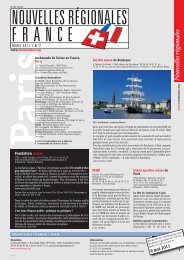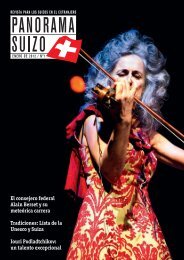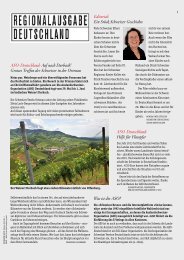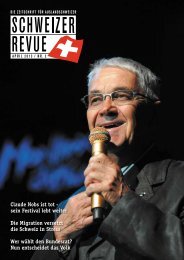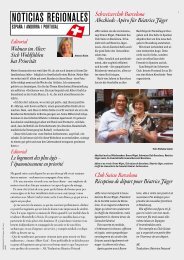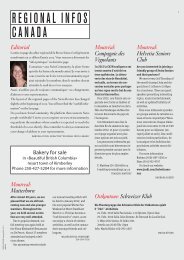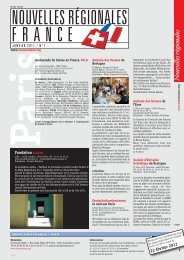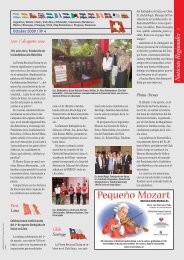Download PDF Swiss Review 1/2013 High Resolution
Download PDF Swiss Review 1/2013 High Resolution
Download PDF Swiss Review 1/2013 High Resolution
You also want an ePaper? Increase the reach of your titles
YUMPU automatically turns print PDFs into web optimized ePapers that Google loves.
Mailbag<br />
Books<br />
5<br />
<strong>Swiss</strong> <strong>Review</strong> February <strong>2013</strong> / No. 1<br />
Photo: ZBG<br />
Great shame<br />
To my great surprise, there was<br />
no mention of the 20th anniversary<br />
of Switzerland’s rejection<br />
of accession to the EU in<br />
the December 2012 issue of<br />
“<strong>Swiss</strong> <strong>Review</strong>”. The vote held<br />
on 6 December 1992 was a momentous<br />
event in our nation’s<br />
history. I believe that this ‘no’<br />
has had detrimental consequences<br />
for our country. It<br />
forces us into bilateral agreements<br />
that are costing us dear<br />
and which we are compelled to<br />
sign. They prevent us from participating<br />
in Europe’s development<br />
and from contributing<br />
our wealth of experience in the<br />
cohabitation of diverse ethnic<br />
and linguistic groups. We are<br />
obliged to take European laws<br />
into account in our legislation<br />
but have no say in European<br />
legislation. Switzerland is in<br />
fact a passive member of Europe<br />
and this is a great shame.<br />
<br />
Max Plattner,<br />
<br />
Lucinges, France<br />
A network of<br />
pilgrimage routes<br />
I have also walked 900 kilometres<br />
along the Way of St James<br />
and would like to point something<br />
out. The Way of St James<br />
is not the only pilgrimage route.<br />
There is an entire network that<br />
stretches across Europe, including<br />
through Germany and<br />
Switzerland. Many of these<br />
routes are not very well developed<br />
and you can walk the entire<br />
day without seeing another<br />
soul and only meet other pilgrims<br />
in the evening at your accommodation,<br />
which is hopefully<br />
available. Many volunteers<br />
keep these routes and lodgings<br />
in good condition and expressly<br />
welcome leisure-time pilgrims.<br />
Many a pilgrim has not just<br />
found himself or herself, but<br />
has also made new or first encounters<br />
with God and faith.<br />
Vivian Fröhlich-Kleinschmidt,<br />
Aurich, Germany<br />
Alternative pilgrimages<br />
I enjoyed reading the article<br />
on pilgrimages in the December<br />
issue of “<strong>Swiss</strong> <strong>Review</strong>”. I<br />
have been living in Sweden for<br />
two years as a <strong>Swiss</strong> abroad.<br />
As a born Catholic theologian,<br />
I have taken on the task of<br />
raising the profile of the pilgrimage<br />
routes and destinations<br />
of the north in Germanspeaking<br />
Europe. When you<br />
talk about pilgrimage destinations<br />
in Central Europe everyone<br />
thinks of Santiago de<br />
Compostela (which really is<br />
very overcrowded). Few people<br />
are familiar with Trondheim<br />
in Norway or Vadstena<br />
in Sweden despite the fact<br />
that Trondheim was the third<br />
most important pilgrimage<br />
destination in Europe in the<br />
Middle Ages.<br />
Pilgrimages here in the north<br />
are calmer and less commercial.<br />
The vastness of the countries is<br />
ideally suited to pilgrimages.<br />
Sibylle Hardegger,<br />
Uppsala, Sweden<br />
Persona non grata<br />
<strong>Swiss</strong> abroad face insurmountable<br />
hurdles in securing<br />
housing, employment and a<br />
decent standard of living<br />
when returning to Switzerland<br />
to stay and live here. Unfortunately,<br />
they do not get<br />
any support from the communes<br />
they originally came<br />
from. It seems as though they<br />
are not welcome. But at election<br />
time they are told that<br />
they are fully fledged citizens<br />
with the same duties and<br />
rights as everyone else, which<br />
unfortunately is not the case.<br />
A communal official told my<br />
daughter when she returned<br />
to Switzerland that she should<br />
have stayed where she was!<br />
What is that supposed to<br />
mean? It means you are a persona<br />
non grata!<br />
Anonymous, by e-mail<br />
Love stories from Switzerland<br />
Love comes. Love goes. And anyone who invites seventeen<br />
authors to write about love sees love come and<br />
go in many different ways, blossoming and foundering,<br />
sometimes growing slowly and sometimes lasting<br />
forever. In “Amami – Liebe mich”, the carefully produced<br />
publication by the recently established “Abendstern<br />
Edizioni” publishing house in Ticino, the authors<br />
do not simply attempt to explain love. They<br />
provide accounts of it. They relate the most intimate<br />
of all emotions. They explore what love does to us and<br />
what we do with love – and how we also sometimes<br />
mistreat it.<br />
The seventeen accounts, many written especially for<br />
the anthology, include the angry, rebellious love of<br />
two teenagers (by Martin R. Dean), calculating,<br />
feigned compassion for a dying person (by Charles Lewinsky)<br />
and tender affections that outlast death, as in Daniel<br />
de Roulet’s tale where an elderly widower tries to scatter<br />
the ashes of his deceased love in the wind only for the wind<br />
to blow them back in his face: “I feel your ashes on my lips<br />
but dare not lick them. Is that not your farewell kiss?”<br />
Containing just under 200 pages, the book reveals subtle<br />
inner reflections from the complex realm of love experienced<br />
by people living in Switzerland. But what actually<br />
makes “Liebesgeschichten aus der Schweiz” (Love stories<br />
from Switzerland), which is the book’s subtitle, a <strong>Swiss</strong><br />
book? All the authors are obviously of <strong>Swiss</strong> nationality.<br />
But, that aside, they are all very different. They speak different<br />
languages, use contrasting writing styles, represent<br />
different generations and, in some cases, have dissimilar<br />
temperaments. Yet, the compilation of literary gems produces<br />
a cohesive picture of lovers in a very small country,<br />
which, despite its size, still breaks down into different living<br />
environments and linguistic regions held together not<br />
least by love. Or, at any rate, they remain fatefully entwined<br />
through love stories.<br />
From that perspective, the book is also something it does<br />
not set out to be – a declaration of love to Switzerland. In<br />
any case, the role played by the small publishing house is<br />
to be commended. It is contributing to new<br />
emotional ties by bringing together in one<br />
work authors who write in Italian, such as<br />
Giovanni Orelli, German-speaking writers like<br />
Anne Cueno, Eveline Hasler, Pedro Lenz and<br />
A U S D E R S C H W E I Z<br />
Peter Stamm, authors with their roots in the<br />
Romansh region, including Oscar Peer, and literary<br />
talents from French-speaking Switzerland,<br />
such as Sylviane Chatelain and Daniel de<br />
Roulet, thus counteracting the trend where one <strong>Swiss</strong> linguistic<br />
region barely recognises the literature produced in<br />
the other <strong>Swiss</strong> languages. The book is therefore also an affectionate<br />
contribution to the miracle of this tiny nation<br />
with its many national languages, but above all it simply<br />
contains stirring literature. <br />
Marc Lettau<br />
L I E B E S G E S C H I C H T E N<br />
“Amami – Liebe mich”, 17 Liebesgeschichten aus der Schweiz;<br />
Abendstern Edizioni, 2012; 195 pages; paperback; available in German<br />
and Italian; CHF 25; EUR 20.



